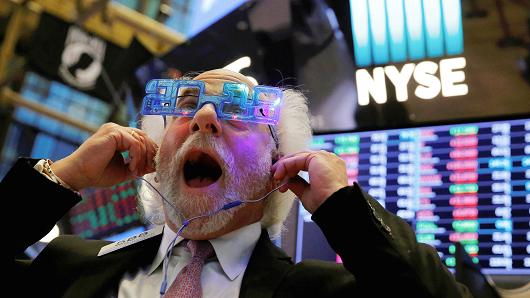
The Dow’s record-fast sprint to 26,000 early in the new year is raising concerns on Wall Street that the stock market may be in danger of overheating.
Indeed, the Dow Jones industrial average’s more than 1,000-point rise from 25,000 to “26K” in the past seven trading days has some investment pros warning that the nearly nine-year-old bull market may be entering its “euphoria phase” — which typically marks the final stage of a long, upward climb for stocks.
The Dow briefly topped 26,000 for the first time Tuesday, rallying almost 283 points to an intraday record high of 26,086.12. But the 30-stock index gave back all its gains and finished the session down 10 points at 25,793.
This stretch of a bull market is characterized by higher share prices, rising investor optimism and fresh cash being funneled into the stock market by investors who fear missing out on gains despite the market’s lofty levels.
The fact that stocks could be entering this phase, however, doesn’t necessarily mean the bull market will unravel overnight.
For example, while then-Federal Reserve chairman Alan Greenspan warned of investors’ “irrational exuberance” in December 1996, the dot-com stock boom didn’t top out until March 2000, or more than three years later.
“We’re in the latter stages of this bull market, but the final stage could last another two or three years given the length of the run so far,” says Chris Zaccarelli, chief investment officer at Independent Advisor Alliance in Charlotte, N.C.
The latest leg up in stock prices has been driven by more than just investor exuberance, however. Other factors fueling the surge this year are the simultaneous growth in economies around the world, and the expected boost to U.S. company profits and the American economy from massive tax cuts. The most common bull market killer — an economic recession — is not on the horizon for now, either, with U.S. GDP growth perhaps getting back to 3% this year.
“The speed at which the market has moved higher in the past two weeks is unsettling and the risk of overheating this year is rising,” Zaccarelli says. “The more expensive the market gets, arguably the more risky it becomes.” A 7% to 12% market drop at some point this year, he says, wouldn’t surprise him.
Signs of soaring optimism — often viewed as “bearish” from a contrarian standpoint — are piling up:
MAIN STREET BUYING SPIKES
In the latest week, $24.4 billion in new cash flowed into stock funds, the sixth-largest amount on record and a “blockbuster” level, according to Bank of America Merrill Lynch.
Main Street investors, who have been on the sidelines for most of the nine-year bull run after getting burned in the last market crash in 2008-09, are turning more optimistic. Last week, the number of individual investors who said they were “bullish” jumped to nearly 60%, the highest reading in more than seven years, according to the American Association of Individual Investors.
FUND MANAGERS BUY IN
What’s more, the average cash balance of fund managers fell to 4.4% in January, a five-year low, according to BofA. That means available money to buy stocks is shrinking. And hedge funds, which have also been cautious on stocks, recently increased their stock market exposure to the highest level since 2006, BofA data show.
ANALYSTS BOOST EARNINGS FORECASTS
In another sign of optimism, Wall Street analysts are boosting their earnings forecasts for U.S. companies at the fastest pace in 10 years, according to Bespoke Investment Group.
Analysts now expect first-quarter profit growth of 15.3% for companies in the S&P 500 stock index, up from 12.2% on Jan. 1. Earnings growth of close to 15% is now also expected for the final three quarters of 2018.
The danger is if stock prices rise too much in such a short period of time, the market gets too far in front of the improving business conditions, experts say.
Too much exuberance could be a dangerous thing, as it suggests Wall Street has gone from not just positive on stocks but “all in,”‘ says Brad McMillan, chief investment officer for Commonwealth Financial Network. “We seem to be seeing that now.”
Edward Yardeni, president and chief investment strategist at Yardeni Research, worries that the market, which he predicted would rise nearly 16% by year-end, will hit his bullish target months ahead of schedule.
That would be a sign of froth, boosting the odds for a stock market pullback.
“No one is getting in early here,” says Yardeni. “And there’s a good chance they are getting in late.”
